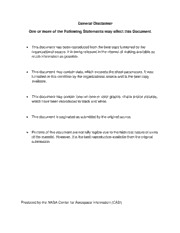
NASA Technical Reports Server (NTRS) 20130011502: Study of Electro-Cyclonic Filtration and Pneumatic Transfer of Lunar Regolith Simulants under 1/6-g and 1-g Gravity Conditions PDF
Preview NASA Technical Reports Server (NTRS) 20130011502: Study of Electro-Cyclonic Filtration and Pneumatic Transfer of Lunar Regolith Simulants under 1/6-g and 1-g Gravity Conditions
General Disclaimer One or more of the Following Statements may affect this Document This document has been reproduced from the best copy furnished by the organizational source. It is being released in the interest of making available as much information as possible. This document may contain data, which exceeds the sheet parameters. It was furnished in this condition by the organizational source and is the best copy available. This document may contain tone-on-tone or color graphs, charts and/or pictures, which have been reproduced in black and white. This document is paginated as submitted by the original source. Portions of this document are not fully legible due to the historical nature of some of the material. However, it is the best reproduction available from the original submission. Produced by the NASA Center for Aerospace Information (CASI) Study of Electro-Cyclonic Filtration and Pneumatic Transfer of Lunar Regolith Simulants under 1/6-g and 1-g Gravity Conditions James G. Mantovani1, Ivan I. Townsend2, Robert P. Mueller1 1NASA Kennedy Space Center, 2ASRC Aerospace NASA has built a prototype oxygen production plant to process the lunar regolith using the hydrogen reduction chemical process. This plant is known as "ROxygen - making oxygen from moon rocks". The ROxygen regolith transfer team has identified the flow and transfer characteristics of lunar regolith simulant to be a concern for lunar oxygen production efforts. It is important to ISRU lunar exploration efforts to develop hardware designs that can demonstrate the ability to flow and transfer a given mass of regolith simulant to a desired vertical height under lunar gravity conditions in order to introduce it into a reactor. We will present results obtained under both 1/6-g and 1-g gravity conditions for a system that can pneumatically convey 16.5 kg of lunar regolith simulant (NU-LHT-2M, Mauna Kea Tephra, and JSC-1A) from a flat-bottom supply hopper to a simulated ISRU reactor (dual-chambered receiving hopper) where the granular material is separated from the convey gas (air) using a series of cyclone separators, one of which is an electrically enhanced cyclone separator (electrocyclone). The results of our study include (1) the mass flow rate as a function of input air pressure for lunar regolith simulants that are conveyed pneumatically as a dusty gas in a vertical direction against gravity under lunar gravity conditions (for NU-LHT-2M and Mauna Kea Tephra), and under earth gravity conditions (for NU-LHT-2M, Mauna Kea Tephra and JSC-1A), and (2) the efficiency of the cyclone/electrocyclone filtration system in separating the convey gas (air) from the granular particulates as a function of particle size.
